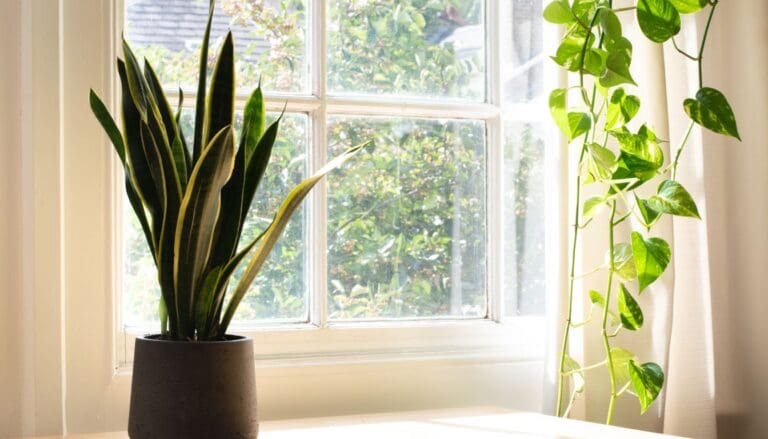9 Reasons Why Your Croton Plant Is Not Growing
Crotons are one of the most popular houseplants loved due to their bright variegated foliage. These plants can grow bushy and make your indoor space look stunning, but you might get worried if your croton is not growing.
So, in this article, we shall learn why is your croton not growing and how to fix the same?
Low light, incorrect watering methods, temperature fluctuations, repotting stress, and pests are common problems due to which your crotons might not be growing. To keep your crotons thriving, provide them with enough sunlight, water them correctly and fertilize them with a mild fertilizer.
Read this article to discover the various problems that crotons undergo, which stops them from growing, and their solutions.
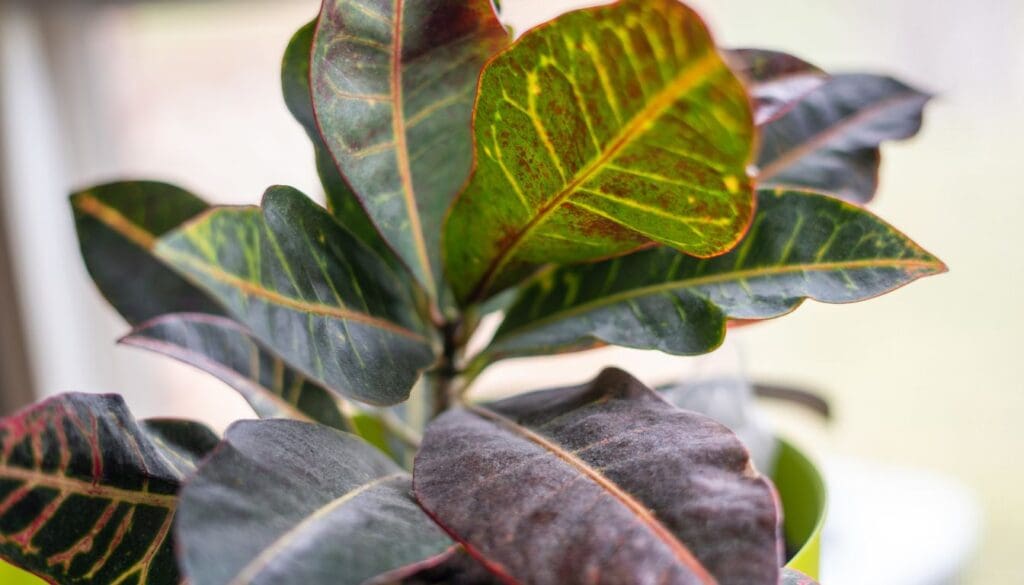
Please note: Simplify Plants is reader-supported. Some links in the post are affiliate links and I get a commission from purchases made through links in the post.
How fast do crotons grow?
Crotons are slow-growing plants.
They gain less than 12 inches a year in their growing season, provided they get an ample amount of light, sufficient fertilizer, and correct soil conditions.
Crotons grow in a dense, compact form and reach 3-8 feet, spreading over 3-6 feet.
Crotons do not go dormant during winters and fall, but their growth rate reduces.
Why is my croton not growing?
Your croton might not be growing because it is not getting the correct care.
If you don’t understand the exact requirements of the plant, you might be making a mistake unknowingly that can hamper the growth of crotons.
But with the right growing conditions and enough care, your croton can show a lot of growth.
Some of the primary problems that stunt the growth of crotons are:
- Low light
- Incorrect watering
- Temperature fluctuations
- Insufficient fertilization
- Repotting and other stress
- Incorrect potting mix
- Wrong pot size
- Pest infestation
- Lack of pruning
These primary issues lead to the slow growth of crotons. Now let’s discuss these in detail.
Low light
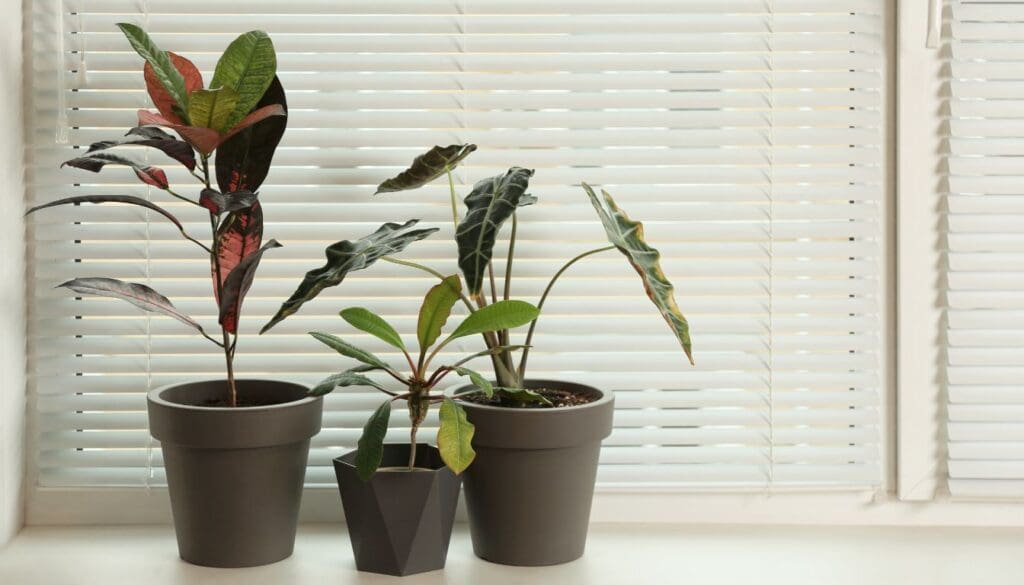
Understanding the sunlight requirement of croton is vital for the healthy growth of the plant.
If the croton does not get the required amount of sunlight, the leaves may start to turn green, lose their luster, and slow down the plant’s growth rate.
The more variegated the leaves are, the higher the plant’s sunlight requirement.
Some croton species can survive in partial shade, whereas others require full sun for six to eight hours.
Overexposure to scorching afternoon sunlight can lead to sunburn and crispy leaves in crotons.
Also read: What Kind Of Light Does A Croton Need? (Croton Light Requirements )
Incorrect watering
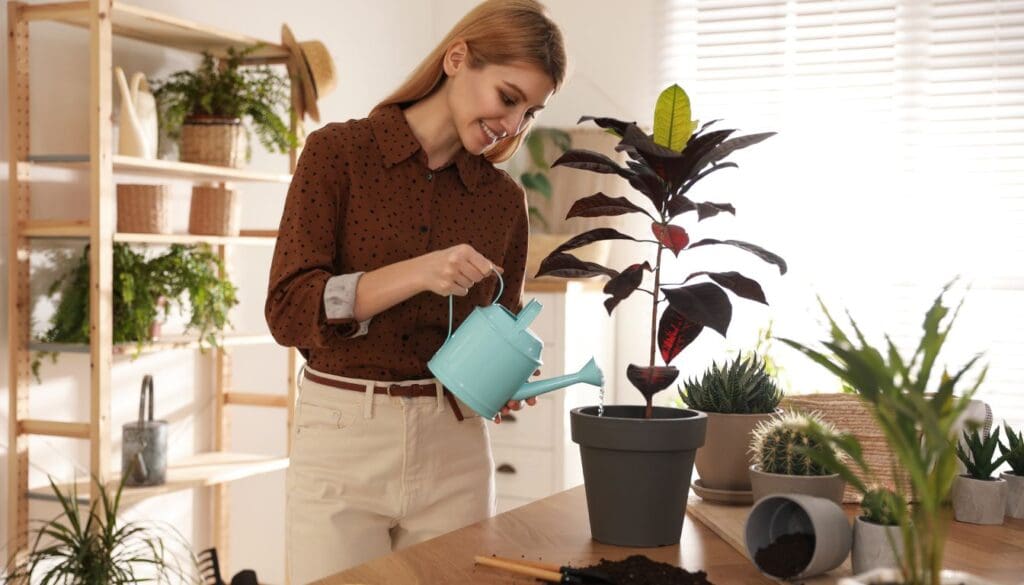
Incorrect watering routine is a significant concern that disturbs crotons.
These plants require moist soil and watering whenever the topsoil goes dry.
Crotons are extremely sensitive to overwatering and underwatering. Both these conditions stop the growth of crotons.
The primary signs of watering issues in crotons are wilting and dry, crispy leaves.
However, the confusion lies here that wilting leaves can be a sign of overwatering and underwatering.
Sometimes the bottom leaves of the plant start falling, which can be a sign of underwatering.
You can revive your croton from underwatering conditions.
But it would be difficult to revive them once overwatering causes root rot.
Also read: How Often To Water Croton Plant? (Watering Schedule+Watering Problems)
Temperature fluctuations
Crotons prefer a humid and warm climate.
Due to freezing weather, they cannot withstand freezing temperatures and start shedding leaves.
You must bring your croton inside when the temperatures go below 40°F.
If you expose your croton to low temperatures or temperature fluctuations, its growth will be compromised.
Not only will the growth of your croton be affected, but the plant will also get damaged.
Also read: What Temperature Can Croton Tolerate? (+Ideal Temperature Range)
Insufficient fertilization

Crotons depend on fertilizers for nutrients.
Since the soil loses its nutrients over time, the fertilizer adds the missing nutrients to the plant’s soil.
In this way, fertilizers support the growth of your croton.
But without sufficient fertilizer, the croton will lack the nutrients that can encourage growth in the plant.
Also read: What Fertilizer Is Good For Croton? (Best Fertilizer For Croton Plant)
Repotting and other stress
Crotons go into shock whenever they experience some form of change.
Repotting is a significant change for the plant where it gets an entirely new potting mix and pot.
This change can send them into shock for a few weeks.
This instantly makes them droopy, and they start losing their leaves.
Crotons will also not respond well to frequent repotting, relocations, drafts, and air currents.
Incorrect potting mix and pot size

Crotons require highly draining soil that is also capable of retaining moisture.
Soggy soil causes root rot, and the leaves begin drooping.
The croton sheds leaves when the soil is too dry to prevent water loss through transpiration.
Wet soil can ruin the plant’s roots, wilting leaves, shedding leaves, and death.
Therefore, choosing suitable soil is very important for the plant’s growth.
Also read: What Kind Of Soil Does A Croton Need? (+Ideal Soil Mix & Requirements)
Wrong pot size
The wrong pot size can stunt the growth of the croton.
If the pot is very small for your croton, it will make the plant rootbound, where the roots will not get enough space for growth.
The roots will start displacing the soil, and the pot can also start breaking due to the pressure from the roots.
A too-big pot will hold more soil and more moisture, leading to overwatering conditions that will not let your croton grow or remain healthy.
Also read: What Kind Of Pot For Croton? (Pot Size, Material & More)
Pest infestation
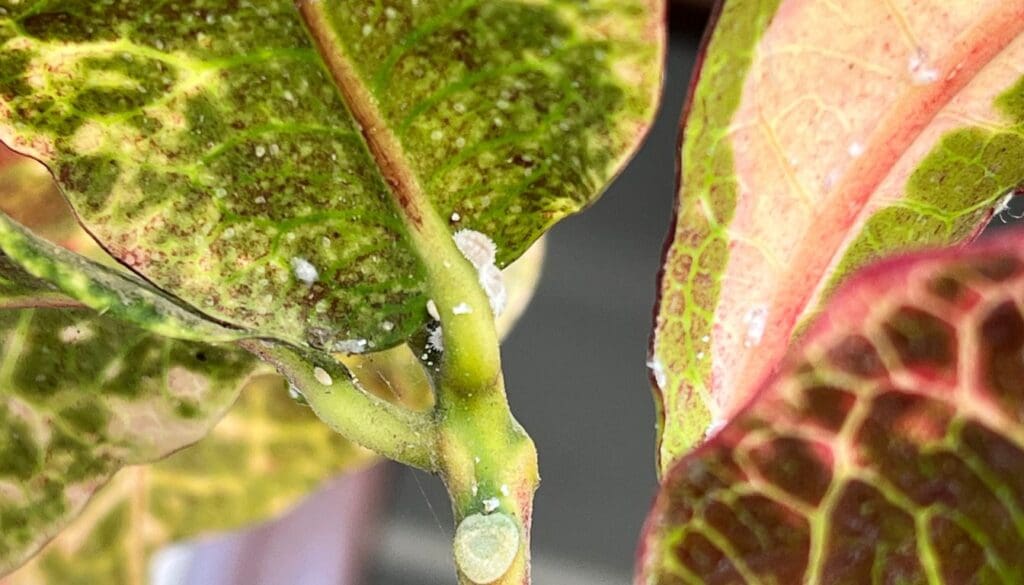
Pests can cause serious risk to the croton and even cause death if not treated on time.
Mealybugs, scales, spider mites, and thrips can attack these plants.
These tiny pests stick themselves to the leaves of the plants, suck the sap and leave sticking honeydew on the leaves.
Pests get attracted to plants living in unfavorable conditions.
Also read: How Do I Get Rid Of Bugs In My Croton Plant? (Common Bugs+Fix)
Lack of pruning
Lack of pruning can also stunt the growth of crotons.
Crotons tend to grow bushy and uneven if you don’t prune them on time.
Without pruning, the dead and damaged parts don’t get removed, so the croton doesn’t have space for new growth.
This condition can reduce the growth rate of your croton.
Also read: How To Make My Croton Bushy? (Possible Problems+Steps)
How can I make my croton grow?
Croton is a favorite among plant owners.
Crotons can grow quickly and happily indoors and outdoors by following the correct tips and ways and giving the plant its required conditions.
Also read: How Fast Do Crotons Grow? (Croton Growth Rate)
Let us find the solution to the most common croton problems.
Give sufficient light

Crotons like full sunlight but may burn from the scorching midday sun.
Neither low light nor too intense sunlight is the requirement of the croton.
Crotons prefer 6-8 hours of full sun or bright indirect light, depending on the variety.
If your crotons have vibrant foliage, they will require more light than those with less bright foliage.
Try to place your croton in a bright spot of the house.
You can also keep your croton in the garden or on the balcony to meet its light requirements.
Keep your croton away from the direct intense sun rays of the afternoon.
If you think your croton is not getting enough light, use artificial lights.
Also read: Why Is My Croton Not Colorful? (Possible Problems+How To Fix)
Proper watering schedule
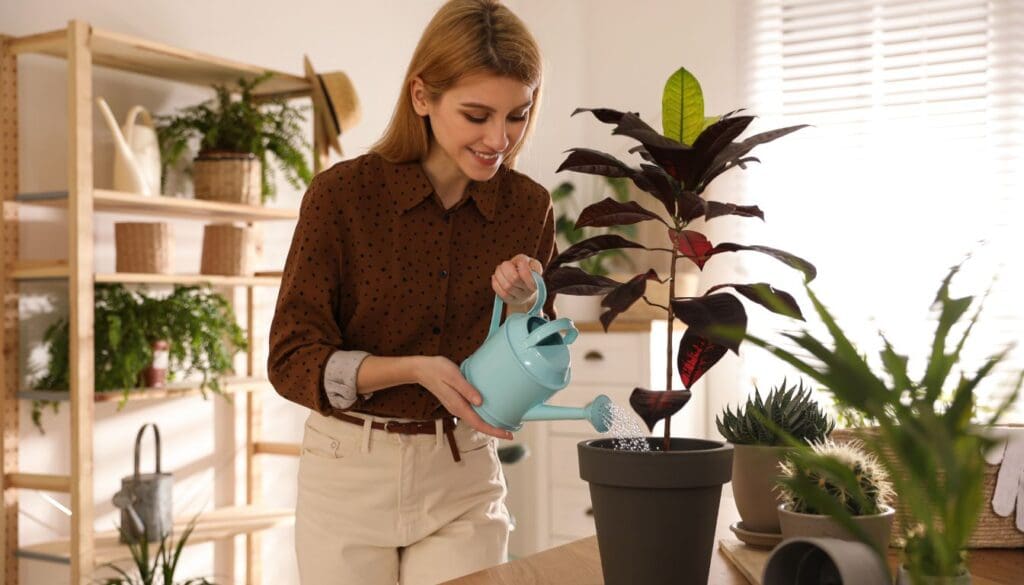
The growing season of crotons is spring and summer when they grow the most actively.
The plant leaves start turning brown and crispy as a sign of watering issues.
During this time, they need maximum water, and you need to check the soil regularly to see whether the top layer has become dry.
If it’s dry, you should water the plant thoroughly until it runs out of the drainage hole.
After this, you should not water the plant again until the topsoil dries completely.
Avoid overwatering at all costs as it can lead to severe issues such as root rot, pest infestation, and other fungal diseases.
If you are forgetful about watering your croton, you can create a watering routine or use a self-watering pot.
Add enough fertilizer
Crotons need a good amount of 3-1-2 NPK fertilizer.
Regular fertilizer will help it grow fast, but you should not do it more than once in 3-4 weeks.
During fall and winter, you can reduce fertilization.
Use a liquid fertilizer as this would work best on your potted croton.
Maintain optimum temperature and humidity

Crotons thrive best in tropical regions where it is warm and humid.
Try to maintain optimum temperatures of 68-95°F and protect the plant from low temperatures of 40°F or below.
If you think your house doesn’t provide enough humidity to crotons, place it where you can group them with other plants to maintain the moisture and humidity.
A humidifier for plants also helps to maintain humidity in dry regions.
Regular misting the leaves can also help retain the plant’s moisture.
Correct soil and pot for the croton
The soil of crotons should be well-draining to prevent root rot, while it has to have the capacity to retain moisture.
One great soil recipe for croton includes:
- 70% of potting soil
- 30% of perlite
This will balance moisture retention and wall drainage.
The pots of croton plants must have holes at the bottom for draining the extra water.
You should also empty the cache tray from time to time so that the croton doesn’t stand on the water for too long.
Repotting the croton plant in well-draining soil and correct pot size can make the plant grow well.
Pest treatment
To save the crotons from pest infestations, you should regularly clean the croton foliage.
In pest infestation, you can clean the leaves with alcohol and water.
This would kill the bugs and clean the plants.
But make sure that this solution doesn’t get to the soil.
Another prevalent pest control technique is using neem oil, an organic insecticide that kills scales, mealybugs, and other pests.
You need to spray the plant thoroughly with neem oil to avoid any escape.
However, you should repeat this treatment a few times to prevent the pests from coming back.
It is vital to keep the leaves of the plants clean as most of the pests attack the underside of the leaves.
While preparing the potting mix, you can also add a handful of neem fertilizer to prevent fungus growth attacks in the soil.
Also read: How Do I Get Rid Of Bugs In My Croton Plant? (Common Bugs+Fix)
Stress
Crotons get stressed quickly due to changes in the location, soil, and light conditions.
They take around 3-4 weeks to come out of the shock and settle in their new habitat.
When the plant goes into stress, it is essential to give time and patience and let it settle and start sprouting new leaves again.
If the leaves become brown and lifeless, gently scratch the stem to find whether the underneath tissues are still fresh.
If it is still green, the plant should recover with proper care.
Pruning and pinching

Besides providing the right growing conditions, two things that can help your croton grow are pruning and pinching.
Pruning is a vital part of croton care.
Pruning is required for removing overgrowth and leggy parts and the dead and damaged foliage.
Pruning the branches where you want more growth can be very helpful for the plant.
Pinching can also boost growth.
If you pinch the new growth areas, you’ll see more growth in those spots.
You can repeatedly prune and pinch to make the plant grow more and more.
Word of caution: While dealing with crotons, do not let the milky white sap of the plant touch the skin, leading to irritation and dermatitis, a type of skin rash.
Final words

Different factors can stop the growth of your crotons, such as inappropriate light, incorrect watering, insufficient fertilizer, and other issues that I have already mentioned in this article.
If your croton is not growing, don’t panic. Try to understand which factor might be responsible for the slow or no growth in your croton plant and fix the issue as per the methods I mentioned above.
You should remember that your croton might not grow much in the winter season as it rests during that time.
You will see some growth but not like the spring and summer seasons. This is nothing to worry about as the plant will grow again when the spring and summer arrive.
Reference: Sciencedirect, Wikipedia, Wikipedia, Britannica, CABI, Academia, University of South Florida, The University of Georgia.
Recommended Garden Supplies
| Product Image | Our Recommended Gardening Supplies | Check Offers! |
|---|---|---|
Top Top
Top
Top
Top
Top
Top
Top
Top | rePotme Houseplant and Tropical Classic Potting Soil Mix | Check Offer On Amazon |
 Top
Top
Top
Top
Top
Top
Top
Top | Espoma Organic Indoor Plant Food | Check Offer On Amazon |
 Top
Top
Top
Top
Top
Top
Top
Top | GooingTop LED Grow Light 6000K Full Spectrum Clip Plant Growing Lamp | Check Offer On Amazon |
 Top
Top
Top
Top
Top
Top
Top
Top | Soil Moisture Meter | Check Offer On Amazon |
 Top
Top
Top
Top
Top
Top
Top
Top | Govee Hygrometer Thermometer, Bluetooth Enabled! | Check Offer On Amazon |
 Top
Top | LEVOIT Humidifiers for Large Room(Best For Plants) | Check Offer On Amazon |
 Top
Top
Top
Top
Top
Top
Top
Top | Upgraded DIY Automatic Drip Irrigation Kit, 15 Potted Houseplants Support | Check Offer On Amazon |
 Top
Top
Top
Top
Top
Top
Top
Top | Stainless Steel Heavy Duty Gardening Tool Set | Check Offer On Amazon |
 Top
Top
Top
Top
Top
Top
Top
Top | Bonide Insecticidal Soap | Check Offer On Amazon |
 Top
Top
Top
Top
Top
Top
Top
Top | Bonide 32 oz Spray Neem Oil for Organic Gardening | Check Offer On Amazon |
 Top
Top
Top
Top
Top
Top
Top
Top | Garden Safe Fungicide | Check Offer On Amazon |




